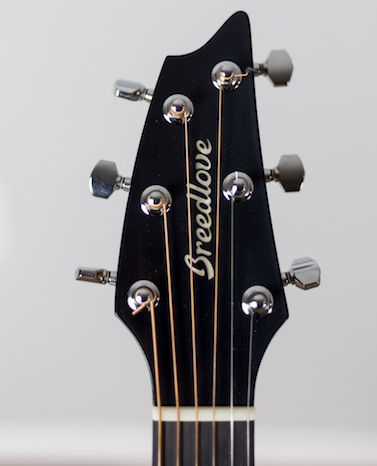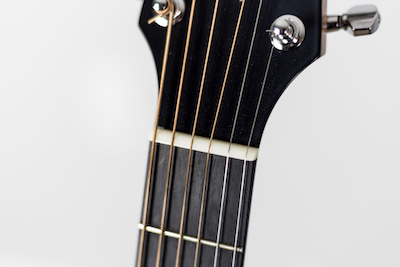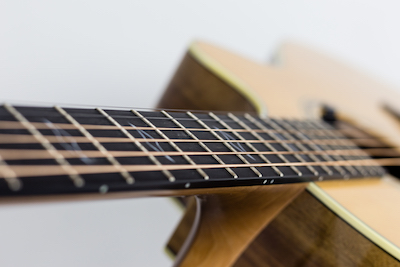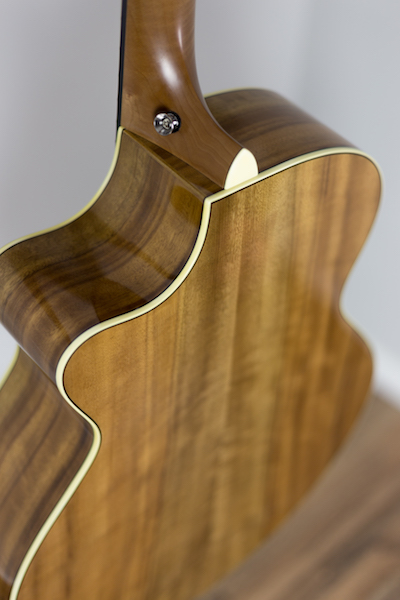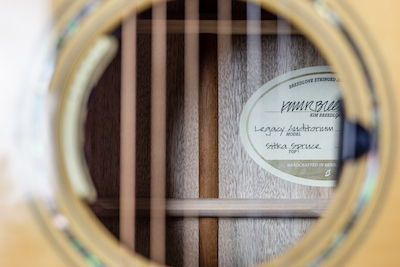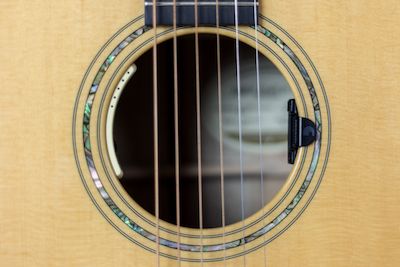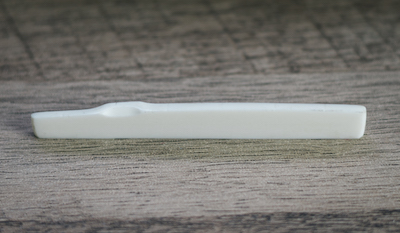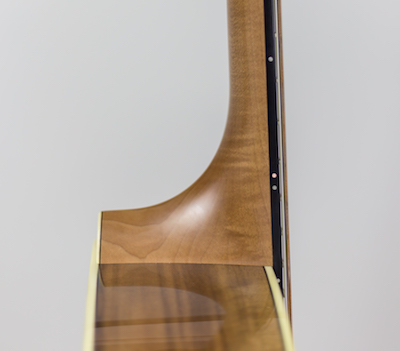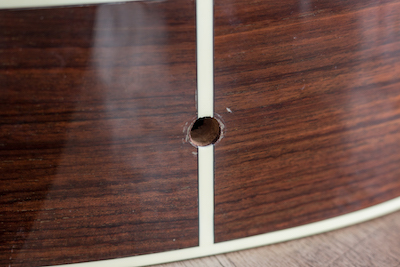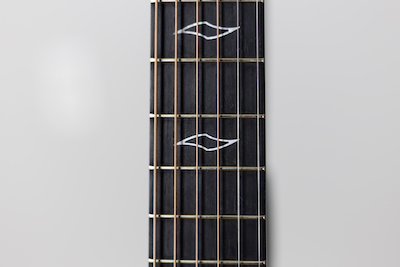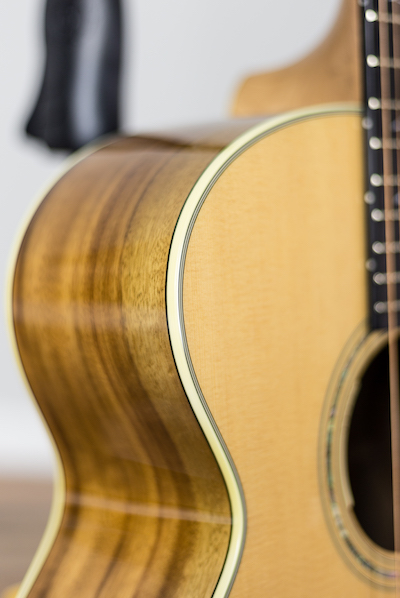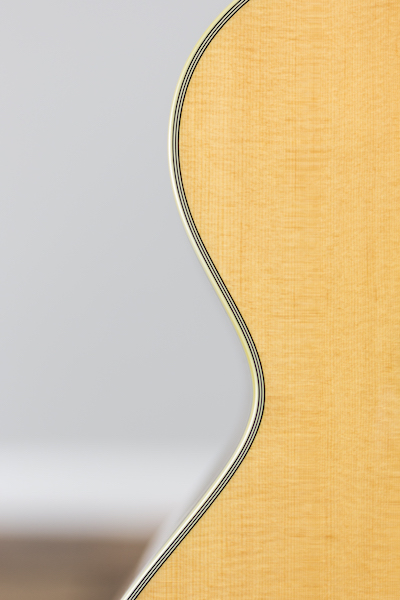Basic Guitar Anatomy
Today we'll be dissecting a healthy young guitar to take a look at the basic terminology and the parts.
Understanding a few basics of guitar anatomy will help you in your studies of the instrument. It may also help you to differentiate a high quality instrument from a poor quality instrument.
The Headstock
The top part of the guitar is called the headstock. It houses the tuning machines, and does little else. Some clever guitar designs even manage to omit a headstock entirely. The headstock is typically a part of the piece of the wood used to make the neck.
Tuning Machines
Your tuning machines are what help you get into tune accurately, and stay in tune.
Logo
Typically a brand name is placed clearly on the headstock.
Nut
The nut is one of two pieces of material upon which the strings rest. The other is at the opposite end of the instrument, at the body.
A nut is usually fashioned from plastic, bone, or similar. It will have six slots for the strings to rest in. Each slot is a different width, and intended to accommodate a different size string.
On a properly set up guitar, the slots are filed as low as possible. If the slots are filed too low, the open string will buzz as the vibrating string rattles across the first fret. So of course the nut slots should not be filed low enough for this to happen. But just above that.
On new instruments, especially those of poor quality, the nut slots are often not filed low enough. From the factory’s perspective, it is safer to ship with the nut slots too high than to file them too low and have to do it again. Time is money.
Neck
The neck of the guitar itself is the piece of wood attached to the body, typically either by a glued-in joint or a bolt-on design. The headstock is a part of the neck. The neck is the playable area of the guitar, where the player presses frets, and so it is very important when actually playing the guitar. The neck has strings suspended above it, metal frets which divide the strings at various lengths to produce different pitches. It also has a fretboard, a typically all-wooden slab on which the frets are installed.
A high-quality neck is important to the overall “feel” of the guitar in your hands, especially with regards to how comfortable and pleasurable it is to play.
Fretboard
The fretboard is a wooden slab, often made of ebony or rosewood, which is installed on top of the neck. As the name suggests, the frets are installed into the fretboard.
Frets
Frets are shiny metal slivers installed along the fretboard at precise positions which, when the string is pushed down, cause the string to be divided into an exact ratio, thus producing a vibration at an intended musical pitch. Fretwork is not easy to do, and quality guitars have frets that are installed smoothly and uniformly.
Some people think of the fret as the wooden “boxes” along the guitar neck, but of course it is actually the metal wire that separates these boxes. However, to play a note at a particular fret, you push down on the string—in the box just before the wire.
The Body
The guitar neck meets the body, where it is joined usually by a glued joint or a bolt-on design. (Some electric guitars are even made from a single piece.)
For the electric guitar, the body is an area of surface meant to be ergonomic to hold, and a host to whatever electronics or hardware are installed on the guitar.
The acoustic guitar body requires more detail, as it is a a three-dimensional cavern that produces sound acoustically.
The Acoustic Guitar Body
The soundboard
The soundboard is the piece of wood that the top of the guitar is made of. It is ordinarily flat. It is sometimes two pieces glued together. Most of the acoustic guitar’s tone is attributed to this piece.
The back and sides
Unlike the soundboard, which is flat and easy to shape from wood, the back and sides have subtle contours in the case of the back, and extreme curvature in the case of the sides. Setting the wood in a curved shape is a labor-intensive process involving steam or heat. For this reason, cheaper guitars use laminate or artificial materials to build the back and sides. These cost-saving processes restrict the vibration of the material, and reduce the quality of the guitar’s sound.
Internal chamber
The internal chamber is the empty space inside of the guitar. If you look inside you will see bracing, or wooden pieces fit together inside of the instrument. The bracing is responsible for supporting the instrument’s body structurally and thus ensuring that its structure remains stable indefinitely. The bracing can also affect the tone of the instrument itself by means of vibrations that are inadvertently (or perhaps deliberately) conducted along the bracing.
The soundhole
The soundhole is an opening in the body that allows the sounds generated by the reverberation chamber inside of the guitar to project outward and be heard.
It’s also a convenient place to tuck electronics, such as an out-of-view pickup system or tuner.
The Bridge
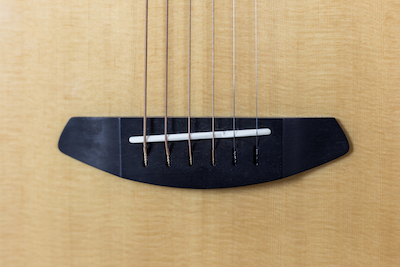
The bridge serves a very important function as the strings are installed here, and they are (hopefully) kept at the correct height by the bridge.
The bridge is a fixture after the soundhole upon which typically rests a saddle, and which may or may not have bridge pins; nevertheless, the bridge is where the strings are installed. The bridge is typically made of a dark wood.
The Saddle
The saddle is a small component upon which the strings rest suspended above the body of the instrument, where they run a straight line to the nut over by the headstock. The saddle is typically made of plastic, bone, or similar.
Bridge pins
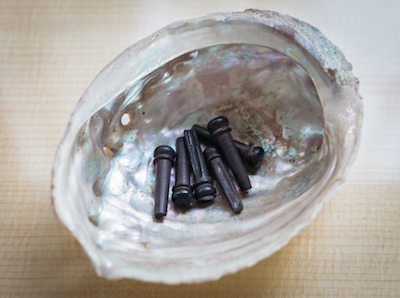
The bridge pins help secure the ball end of a steel string into the bridge. Storing them in an abalone shell is an optional luxury.
Bridge pins are small pins which secure the strings. The strings are fed into a hole in the bridge, and the pins are placed over them to keeping them from coming out again. Some guitars are pinless, meaning the strings are fed through a hole in the bridge. Classical guitars are designed this way.
Bridge pins don’t need to be snug to secure the strings in place. Most of that work is done by the string itself, once it’s brought up to tension.
The Heel
Acoustic guitar necks will have a back side. The end of this side is often decorated with an ornate cap. Because this part of the guitar is made of solid wood, strap pins are sometimes installed here so that the instrument can be worn via a strap. The other pin is typically on the end block.
The guitar neck is traditionally glued in via a traditional wordworking method using a dovetail joint. Modern guitars area often designed to be bolted on instead.
Proponents of the traditional glued neck argue that it is better for sound transfer. Advocates of the newer neck point out that it makes repairs much more affordable.
The End Block
One more feature of acoustic guitars is worth mentioning. The bottom of the instrument typically has a solid block where the curled sides meet in the middle. This block traditionally has an end pin installed, although nowadays the end pin is sometimes left out in favor of a quarter-inch jack in order to connect the guitar’s electronics to an amplifier.
The end block is a good place to install a strap pin because it is a solid piece of wood.
Cosmetic features
In addition to structural features, guitars will sometimes have purely cosmetic features. These are especially common on high end guitars, and the gaudiest of the lower-end guitars.
End pin inlay
The end pins are sometimes inlayed with abalone, or other fancy decorative material.
Fretboard inlays
Fretboard inlays are common. They may be simple “dots” to mark common fret positions such as III, V and VII; or they may be artistic renditions of any sort. They may be made from wood, abalone, or many other materials.
Binding
Binding is the material used to connect the top and sides of the guitar. It is not really optional on the body of the instrument, where multiple sides must be joined together. But it may sometimes be made of a fancy and ornate material. It is also completely optional on the fretboard. If the fretboard has binding, this is usually an aesthetic feature.
Purfling
Purfling is a purely decorative step added to the binding process to make the binding material more visually striking. Purfling could add a simple line tracing along the face of the instrument where the binding was installed, as on many instruments. Or it could be made from an ornate and decorative material.
Electronics
The guitar may host several electronic devices, either embedded into the instrument during the manufacturing process or added later on.
Electronics typically serve to amplify the sound, to modify the sound, or to tune the guitar.
Pickups
Electric guitars are fitted with one or more magnetic devices called pickups which transduce the vibrating sound into an electrical signal that can be piped through an amplifier. An electric guitar will sometimes have several pickups, and a lever allowing the player to switch back and forth between them, achieving different sounds depending on the pickup used and its position on the guitar.
Acoustic guitars most often have a transducer (aka pickup) installed under the saddle, where the string vibration signal is clearest. Unfortunately, capturing this one signal is not enough to truthfully represent the sound of the acoustic guitar. Higher-end pickup systems may combine such a transducer with an additional microphone embedded in the body of the guitar. Blending these two sounds together produces a more true representation of the guitar’s tone.
The pickup is usually plugged into an amplifier via a quarter-inch instrument cable.
Active electronics refers to a pickup system that requires electricity to operate (normally a battery); passive electronics will work without a battery.
Tone Control
A tone control is a knob that allows the player to adjust the sound of the instrument’s electronic output. This is normally achieved by analog circuitry that pipes varying levels of high frequencies through a capacitor, thus removing them from the signal chain. The frequencies removed are decided by the strength of the capacitor in the guitar. A high-value capacitor will cut off lots of signal, resulting in a dark tone. A low-value capacitor will not take as much high-end off, and consequently will sound very bright.
There are other possibilities for tone controls, especially if the guitar has an active pre-amp system which might even have a built-in equalizer in some cases.
Tuner
Some guitars have a tuner built-in to the body of the instrument, aiding in the tuning of the instrument. Some guitars even have tuning machines with an automated tuner function, so that they can tune themselves to the correct pitch automatically.
Other
Of course, given today’s technology there are many intriguing possibilities for guitar electronics and many of them have made it to the production line and onto mass-distributed instruments. But the electronic features discussed above are the most common.
 As the creator of Hub Guitar, Grey has compiled hundreds of guitar lessons, written several books, and filmed hundreds of video lessons. He teaches private lessons in his Boston studio, as well as via video chat through TakeLessons.
As the creator of Hub Guitar, Grey has compiled hundreds of guitar lessons, written several books, and filmed hundreds of video lessons. He teaches private lessons in his Boston studio, as well as via video chat through TakeLessons.